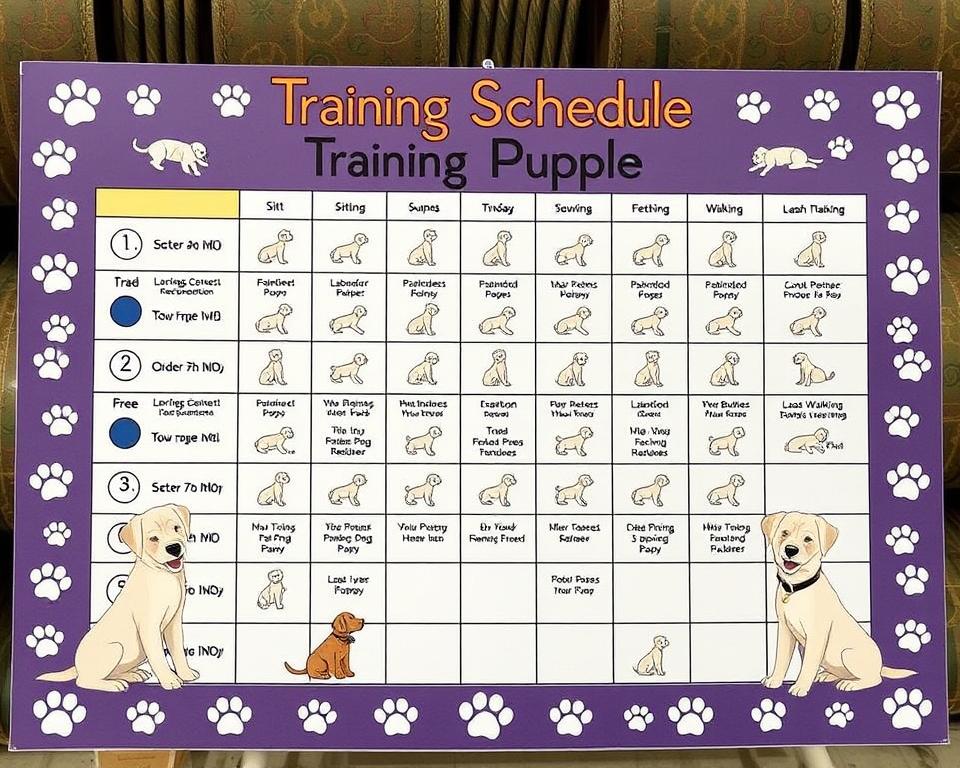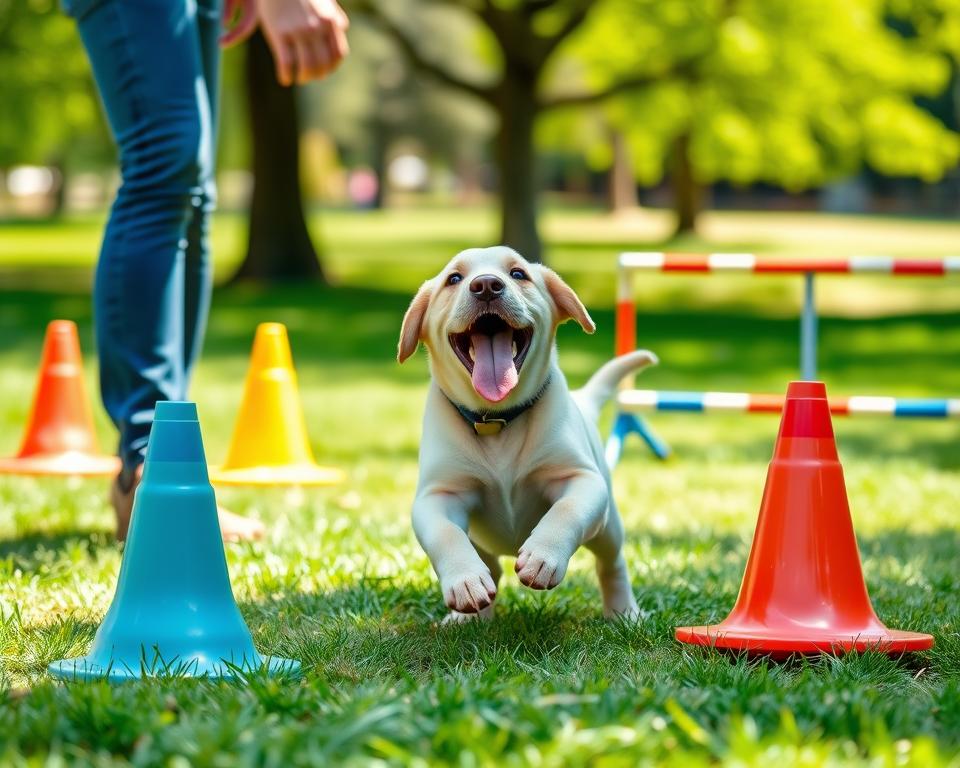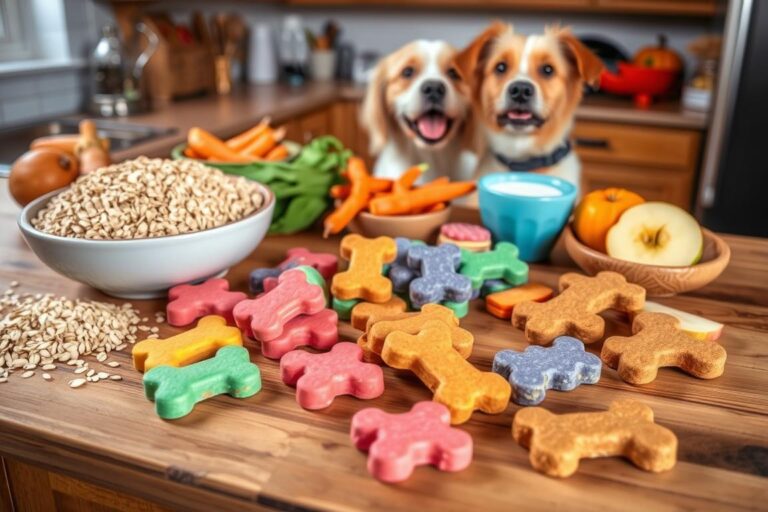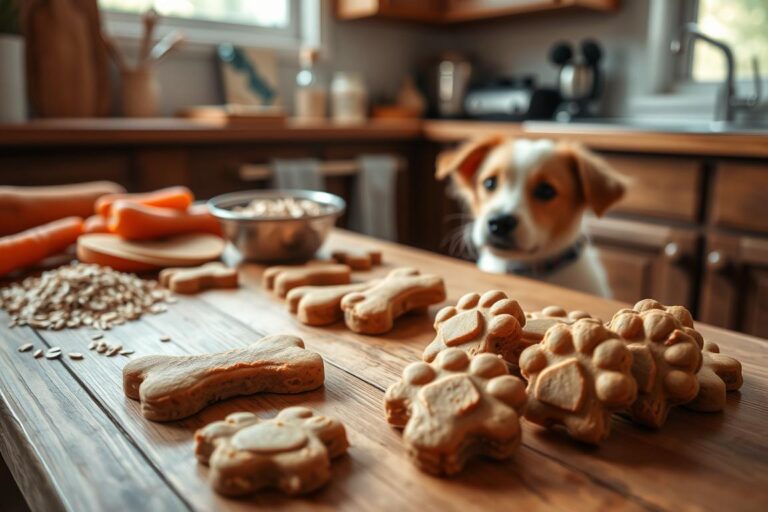Best Way to Train a Labrador Retriever Puppy | Guide
Training a Labrador Retriever puppy needs understanding their special needs and personality. They are friendly and full of energy. This makes training key for a good pet.
We will look at good puppy training methods for Labradors. Starting training at 9-10 months helps teach important commands and social skills. This sets the stage for good labrador retriever obedience training.
We will share useful tips and strategies. These help our dogs learn important commands and stay happy and healthy. From setting goals to playing together, every step is important. Let’s explore the amazing world of Labrador training!
Understanding the Labrador Retriever Breed
Learning about the Labrador Retriever breed is key for future owners. These dogs are known for being friendly and easy-going. They are smart and love to please us.
Temperament and Personality Traits
Labrador Retrievers have lots of energy and love life. They love being around people, making them great family pets. Early socialization is vital for their growth.
This helps them become confident and well-adjusted. Their friendly nature makes them perfect for jobs like therapy and guide dogs.
Common Behavior Issues
Labradors can have behavior problems if they’re not active enough. They need at least an hour of playtime every day. Without it, they might chew, bark, or dig.
Having lots of toys and activities can help. Early training is key to prevent these issues. It helps them learn good habits early on.
The Importance of Early Training
Early training is crucial for a well-behaved Labrador. Training them when they’re young takes advantage of their eagerness to learn. Positive reinforcement works well with their nature.
Starting early helps them learn important skills. This way, they can live a happy and balanced life. It also reduces the risk of future problems.
Setting Training Goals
Setting clear goals is key to training our Labrador puppies well. We need to have both short-term and long-term goals. Short-term goals are about learning basic commands. Long-term goals are for more complex skills.
Short-Term vs. Long-Term Goals
Short-term goals are about quick tasks like SIT and HERE. Puppies can learn these early, when they are full of energy. We should aim for goals that are doable and get harder as we go.
Long-term goals are about learning harder things. They include doing things even when there are distractions.
Prioritizing Essential Commands
Choosing what to teach first is important. We should start with basic commands that are important for later skills. For example, teaching HERE helps with recall and control.
Training in different situations helps puppies learn to focus no matter what. This makes our bond stronger and makes training easier.
Training Methods to Consider
Choosing the right training methods for a Labrador puppy is key. Positive reinforcement and clicker training are top choices. They reward good behavior, making learning fun. Being consistent is vital for lasting results.
Positive Reinforcement Techniques
Positive reinforcement uses treats, praise, or play to reward good behavior. It works well with smart Labradors. This method builds trust and encourages good behavior.
It helps solve problems like barking or chewing. Our dogs feel safe and understood.
Clicker Training Essentials
Clicker training is clear and effective for Labradors. A clicker signals when a behavior is correct. This helps our dogs learn fast.
We can use it with positive reinforcement. For example, a click and treat when they sit. This makes learning fun and clear.
Consistency in Training Approach
Consistency is crucial for good training. Regular commands and sessions help our dogs learn. A routine with positive reinforcement helps them learn best.
This approach reduces confusion. Our dogs learn important skills and manners.
| Training Method | Description | Benefits |
|---|---|---|
| Positive Reinforcement | Rewarding desired behaviors with treats and praise. | Builds trust, encourages cooperation, and decreases behavioral issues. |
| Clicker Training | Using a clicker as a marker for good behavior. | Enhances communication, allows quick feedback, and improves understanding. |
| Consistency | Repeating commands and maintaining a structured approach. | Reinforces learning, reduces confusion, and encourages positive responses. |
Creating a Training Schedule
A good training schedule is key for teaching our labrador puppies. It helps them learn better by being consistent. Daily sessions of 5-10 minutes keep them focused and happy.
Adding playtime to training makes it fun. It helps them learn commands better.
Daily Training Sessions
We set up daily training to teach new things. At first, we teach basic commands like “follow me” and “recall.”
When they get older, we teach them to walk on a leash. By 5-6 months, they learn more complex skills. This makes them behave better and understand commands better.
Incorporating Playtime and Relaxation
Playtime is important in our training plan. It keeps our puppies excited to learn. After training, playtime is a reward.
Playing games like retrieving helps them exercise and learn. Resting after play helps them remember what they learned. This makes our training plan work well for labrador puppies.

Essential Commands Every Puppy Should Learn
Training our Labrador puppies with essential commands is key. We start early, around 8 weeks old. This builds a strong base.
Training sessions should be short, 5 to 10 minutes. This keeps our puppies interested and happy.
Sit and Stay
The “sit” command can be taught in fun ways. Once they get it, we add “stay.” This means they stay sitting until we say it’s okay.
Learning these commands helps them behave well. They listen better during walks and meals.
Come and Heel
The “come” command keeps our puppies safe. It lets them come back to us, even when there’s a lot going on.
The “heel” command means they walk by our side. This is important for good walking habits.
Down and Leave It
The “down” command is like “sit” but on the ground. It teaches self-control.
“Leave it” stops bad behavior. It tells our puppies to ignore things they shouldn’t touch. These commands are important for discipline and a good training experience.
Socialization: Key to a Well-Behaved Dog
Socializing a Labrador retriever puppy is key for their behavior and confidence. Early exposure to different places, sounds, and people helps them grow well. Supervised interactions can prevent bad behavior later.
Exposing Your Puppy to Different Environments
We start exposing puppies to new things when they are 3 to 14 weeks old. Taking them to pet stores and on walks helps them adapt. This time is very important for their future behavior.
Meeting Other Dogs and People
After getting their shots, puppies can go to classes with other dogs and people. These classes help them learn to be calm and friendly. Celebrate small wins, like staying calm around new dogs.
We should not overwhelm our puppies. Slowly introducing them to new things helps avoid fear and anxiety.
Addressing Behavioral Issues
Starting our training journey early is key. It helps our puppies grow into well-adjusted dogs. Each puppy is different, showing unique behaviors. Knowing why they act certain ways helps us find the right solutions.
Biting and Chewing
Puppies bite and chew because of teething or boredom. Giving them the right chew toys is important. This stops them from chewing on things they shouldn’t.
Using positive training helps them learn what’s okay to chew on. It’s easier to stop bad habits early on.
Jumping and Barking
Jumping and barking can mess up our day. Teaching them to be quiet or calm helps. We can also teach them to greet people calmly.
This training helps them learn better manners. It’s good for everyone.
Separation Anxiety Solutions
Helping puppies with separation anxiety means teaching them to be okay alone. Crate training helps them feel safe. This builds their confidence and reduces anxiety.
| Behavioral Issue | Recommended Solutions | Prevention Tips |
|---|---|---|
| Biting and Chewing | Provide appropriate chew toys, utilize positive reinforcement | Puppy-proof the home, supervise playtime |
| Jumping | Train with commands like “sit,” reward calm behavior | Encourage polite greetings, consistency among caregivers |
| Barking | Use “quiet” or “enough” command, positive praise | Identify triggers, provide mental stimulation |
| Separation Anxiety | Gradual desensitization, crate training | Start alone time early, provide a safe space |
The Role of Exercise in Training
Exercise is key for Labrador puppies. It helps them be well-rounded and behave well. Activities like fetch and agility training build muscle and teach commands.
Training should last 15-20 minutes every other day. Adding games to our routine makes them more focused and quick to respond.
Physical Activity vs. Mental Stimulation
Exercise and mental challenges are both vital. Puppies need at least five minutes of exercise per month of age until they’re fully grown. This usually takes 18-24 months.
A 12-month-old Labrador needs an hour and a half of exercise daily. As they get older, they need more. Young Labradors do best with activities that match their age and growth.
- Daily walks to expend energy.
- Enjoyable games like tug-of-war and Frisbee toss.
- Structured agility courses that provide both physical and mental engagement.
- Indoor activities such as treadmill training and hide-and-seek.
Games That Help Reinforce Training
Games are not just fun; they help learn too. Activities like fetch and agility running teach commands and improve skills. Using a recall whistle during play makes our puppy more responsive.
Teaching patience by increasing sitting time helps them focus and behave. This is important for their health and behavior.
It’s crucial to remember our puppies’ physical limits. With the right exercise, we can prevent joint problems and fractures. This makes them healthy and happy companions.
| Age of Labrador | Recommended Exercise Duration | Activities |
|---|---|---|
| Under 1 year | 5 minutes per month of age | Fetch, Tug-of-War, Indoor Obstacle Courses |
| 12 months | 1.5 hours daily | Agility Running, Frisbee Toss |
| 4 years and older | 1-2 hours daily | Walking, Structured Play, Mental Challenges |
The Importance of Patience and Persistence
Training a Labrador Retriever puppy needs patience and persistence. Each puppy learns at its own speed. This shows us how dogs learn in their own way.
Trainers use different methods to teach commands. This shows that every dog is unique. They need training that fits their needs.
Understanding Learning Curves
It’s important to know how dogs learn. The bond between the owner and puppy affects training. Tools like food rewards and clickers help in training.
Some puppies learn fast, while others take time. They need consistent training to learn important behaviors.
Dealing with Frustration
Frustration can happen during training. Changing behaviors like jumping or barking takes time. It’s key to stay patient.
Ending training sessions on a positive note is important. Regular breaks help too. Consistent training makes us and our dogs happy in the end.
Involving the Whole Family in Training
Getting everyone in the family to help with puppy training makes it better for our dogs. It means everyone knows what to do and does it the same way. This teamwork makes learning easier for our Labrador Retriever.
Creating Team Consistency
It’s key to have everyone use the same commands and ways to train. This avoids confusion for the puppy. Using the same words like “sit,” “stay,” and “come” helps the puppy learn faster and feel more secure.
Here are some ways to keep everyone consistent:
- Choose one person to lead the training.
- Practice commands together often.
- Keep everyone updated on training progress.
Age-Appropriate Responsibilities
Letting kids help with training is good for them. It teaches them respect, empathy, and teamwork. Here are tasks for different ages:
| Age Group | Responsibilities |
|---|---|
| Under 5 years | Holding treats and encouraging the puppy during training. |
| 5-8 years | Assisting with basic commands and providing praise. |
| 9-12 years | Taking part in structured training sessions and learning clicker techniques. |
| 13+ years | Leading training sessions, taking responsibility for walks, and reinforcing commands. |
Working together in puppy training creates a great environment for our Labrador Retriever. By being consistent, we help our puppy grow strong.

Resources for Continued Learning
Training our Labrador Retriever puppies is a big journey. We need many puppy training resources to learn and grow. Books and online courses on Labrador training are great. They teach us new things and help with tough issues like bad behavior.
Looking into puppy training stages, potty training, and recall methods is smart. These topics help a lot.
Recommended Books and Online Courses
There are many books and courses for Labrador training. They give us step-by-step advice for this smart breed. Positive reinforcement and rewards work well, helping us bond with our dogs.
It’s important to use methods we already know. This keeps our training consistent.
Finding Professional Help When Needed
Training our dogs is great, but sometimes we need help. Knowing when to get a professional dog trainer is key. They can help with problems like jumping, pulling on the leash, or feeling anxious when we leave.
Trainers offer support and help us solve problems. They make sure our dog is well-behaved and happy everywhere we go.







